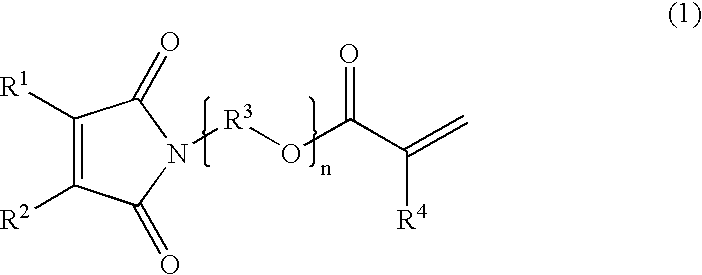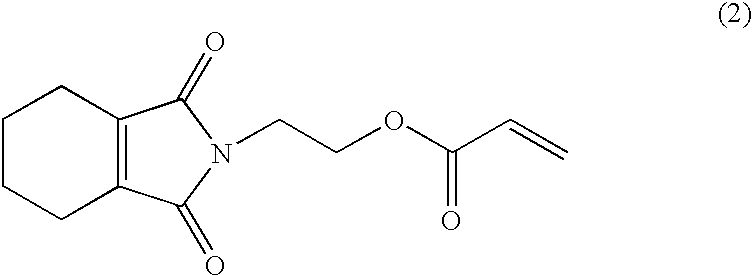Pressure-sensitive adhesive composition curable with actinic energy ray and pressure-sensitive adhesive sheet
a technology of pressure-sensitive adhesives and actinic energy rays, which is applied in the direction of film/foil adhesives, amide/imide polymer adhesives, transportation and packaging, etc., can solve the problems of deterioration of storage stability, damage to coatability, and two-pack compositions still suffering, etc., to achieve excellent curability and excellent performance as pressure-sensitive adhesives.
- Summary
- Abstract
- Description
- Claims
- Application Information
AI Technical Summary
Benefits of technology
Problems solved by technology
Method used
Image
Examples
example 1
1) Preparation of Pressure-sensitive Adhesive Composition
0.5 Grams of the compound of the formula (2), 94.0 g of BA, 5.0 g of AA, 0.5 g of HEA, 100 g of butyl acetate, and 0.5 g of 2,2'-azobis(2-methylbutyronitrile) (hereinafter referred to as "AMBN") as a polymerization initiator were charged in a flask equipped with a stirrer, a thermometer and a condenser at room temperature and were homogeneously dissolved. Then, the content was heated and stirred at 85.degree. C. for 2 hours and at 95.degree. C. for 1 hour.
The resulting copolymer solution had a solid content of 50%, a number-average molecular weight of 52000 and a weight-average molecular weight of 140000.
The resulting copolymer solution was a pressure-sensitive adhesive composition and referred to as adhesive a1.
2) Production of Pressure-sensitive Adhesive Sheet
The composition a1 was coated on the surface of a polyethylene terephthalate film of 25 .mu.m thick so that thickness of the adhesive layer after dried became 20 .mu.m,...
examples 2-5
Copolymers were prepared in the same manner as in Example 1, except that the monomers as shown in Table 1 were used. The resulting solutions of the copolymers were used as pressure-sensitive adhesive compositions.
Pressure-sensitive adhesive sheets were produced in the same manner as in Example 1 using the resulting compositions and were evaluated in the same manner as in Example 1. The results are shown in Table 2.
The pressure-sensitive adhesive compositions of Examples 2-5 were superior in all of adhesive strength, holding power and tackiness, and, besides, the cured coating film had no odor.
example 6
100 Parts of the copolymer solution obtained in Example 1 was mixed with 2.5 parts of TPGDA and 0.25 part of benzyl dimethyl ketal to prepare a pressure-sensitive adhesive composition. This was referred to as adhesive a6.
A pressure-sensitive adhesive sheet was produced in the same manner as in Example 1 using the adhesive a6 and was evaluated in the same manner as in Example 1. The results are shown in Table 2.
The pressure-sensitive adhesive composition of Example 6 was superior in all of adhesive strength, holding power and tackiness, and, besides, the cured coating film had no odor.
PUM
| Property | Measurement | Unit |
|---|---|---|
| glass transition temperature | aaaaa | aaaaa |
| glass transition temperature | aaaaa | aaaaa |
| thickness | aaaaa | aaaaa |
Abstract
Description
Claims
Application Information
 Login to View More
Login to View More - R&D
- Intellectual Property
- Life Sciences
- Materials
- Tech Scout
- Unparalleled Data Quality
- Higher Quality Content
- 60% Fewer Hallucinations
Browse by: Latest US Patents, China's latest patents, Technical Efficacy Thesaurus, Application Domain, Technology Topic, Popular Technical Reports.
© 2025 PatSnap. All rights reserved.Legal|Privacy policy|Modern Slavery Act Transparency Statement|Sitemap|About US| Contact US: help@patsnap.com



